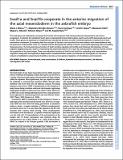Por favor, use este identificador para citar o enlazar a este item:
http://hdl.handle.net/10261/32376COMPARTIR / EXPORTAR:
 SHARE SHARE
 CORE
BASE CORE
BASE
|
|
| Visualizar otros formatos: MARC | Dublin Core | RDF | ORE | MODS | METS | DIDL | DATACITE | |

| Título: | Snail1a and Snail1b cooperate in the anterior migration of the axial mesendoderm in the zebrafish embryo |
Autor: | Blanco Fernández de Valderrama, María José; Barrallo-Gimeno, Alejandro CSIC ORCID; Acloque, Hervé CSIC ORCID; Reyes, Ariel E.; Tada, Masazumi; Allende, Miguel L.; Mayor, Roberto; Nieto, M. Ángela CSIC ORCID | Palabras clave: | Extension Prechordal plate Axial mesendoderm E-Cadherin Epithelial-mesenchymal transition Cell adhesion Cell migration DDC model |
Fecha de publicación: | 15-nov-2007 | Editor: | Company of Biologists | Citación: | Development 134(22): 4073-4081 (2007) | Resumen: | The Snail genes are implicated in processes that involve cell movement, both during embryonic development and tumour progression. In teleosts, the vertebrate Snail1 gene is represented by two distinct genes, snail1a and snail1b (previously snail1 and snail2). These genes are expressed in complementary mesodermal domains and their combined expression matches that of their mammalian counterpart. By analysing their loss and gain of function, we found that the most-anterior axial mesendodermal cells, the precursors of the polster, move in a cohesive manner directed by the activity of snail1a- and snail1b-expressing cells surrounding these precursors. The cell-autonomous function of Snail1 proteins regulates cell motility and influences the behaviour of Snail-negative neighbouring cells. Snail1a is required by the prechordal plate for it to reach its normal position, whereas Snail1b controls the acquisition of its normal shape. These non-redundant functions of Snail1a and Snail1b in controlling axial mesendoderm migration comply with the duplication-degeneration-complementation model, and indicate that Snail genes not only act as inducers of epithelial-to-mesenchymal transition, but also as more general regulators of cell adhesion and movement. | Descripción: | 9 páginas, 7 figuras. | Versión del editor: | http://dx.doi.org/10.1242/dev.006858 | URI: | http://hdl.handle.net/10261/32376 | DOI: | 10.1242/dev.006858 | ISSN: | 0950-1991 |
| Aparece en las colecciones: | (IC) Artículos (IN) Artículos |
Ficheros en este ítem:
| Fichero | Descripción | Tamaño | Formato | |
|---|---|---|---|---|
| 4073.full.pdf | 6,63 MB | Adobe PDF |  Visualizar/Abrir |
CORE Recommender
SCOPUSTM
Citations
61
checked on 31-mar-2024
WEB OF SCIENCETM
Citations
62
checked on 27-feb-2024
Page view(s)
372
checked on 18-abr-2024
Download(s)
294
checked on 18-abr-2024
Google ScholarTM
Check
Altmetric
Altmetric
NOTA: Los ítems de Digital.CSIC están protegidos por copyright, con todos los derechos reservados, a menos que se indique lo contrario.
